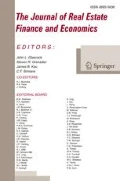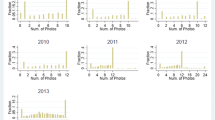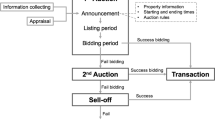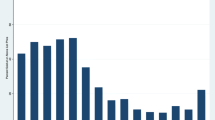Abstract
The primary function of Multiple Listing Services (MLS) in housing markets is to disseminate information from listing brokers to other member brokers about houses listed for sale. This study examines the impacts of MLS-member information sharing intensity on housing market outcomes, with information sharing intensity measured as the average daily number of times MLS members view an individual house’s listing during its marketing period. We develop a theoretical model and derive the equilibrium. The model predicts that increased information sharing intensity leads to greater probability of sale, reduced time on market, and higher house prices. Analysis of data from 32,102 listing records validates the model’s propositions. We find that a one-unit increase in the average daily number of views of a house’s listing increases the probability of a successful transaction by 5.7%, increases selling price by 0.2%, and reduces marketing time by 1.6 days.
Similar content being viewed by others
Notes
“Broker,” as used here, refers to both brokers and sales associates, regardless of state license type.
MLS also serve as data repositories for historical information about expired, withdrawn, and closed listings.
MLS also distribute selected information about available houses to the general public, though full information, including, but not limited to historical information, is restricted to members. This study focuses exclusively on information sharing between MLS-member brokers.
As noted by an anonymous reviewer, the current study does not address the simultaneity could be a concern if price is a determinant of number of MLS views. Also, the current study does not consider the number of buyers searching for a particular type of house and the number of such houses available in the market. In thin markets, omitted variable bias may be a concern.
For more insights about this evolution, see Federal Trade Commission Report (1983).
For details of this litigation, see the case filings available at www.justice.gov/atr/public/real_estate/enforce.html (accessed on 5/24/2016).
MLS report offers of compensation to cooperating brokers, but do not report total actual commissions paid to brokers. The commission rate data used by Jia and Pathak (2010) are limited to the compensation offered in the MLS by listing brokers to cooperating brokers, which Jia and Pathak assume is exactly half of the actual total commission paid by house sellers to brokers. This assumption may result in a biased measure of commission rates if listing brokers accept different commission rates than those offered to cooperating brokers or if the commission rate and/or splits are renegotiated between the listing and closing dates. Actual commission is typically recorded on HUD-1 Settlement Statements, but these are proprietary documents that are not easily obtainable.
See Han and Strange (2015) for useful discussions of this and other related issues within the larger context of the microstructure of housing markets.
Arnott (1989) provided a formal model with this attribute.
Our model does not analyze the listing agent’s effort choices. Previous literature (Rutherford et al. 2005 and Bian et al. 2015) shows that many factors affect listing agent’s optimal effort choice. We assume the listing agent takes into consideration the relevant factors and determines the expected effort level before choosing information sharing intensity. Thus, we take listing agent’s effort level as given when modeling the choice of information sharing intensity.
We follow the standard assumption that the listing agent has unlimited time to arrange a sale.
This footnote shows the proof of the statement: since EP(x) =\( {\int}_x^{\infty}\frac{Pf(P) dP}{\left(1- F(x)\right)} \), we could derive\( \frac{\partial EP(x)}{\partial x}=-\frac{ x f(x)}{\left(1- F(x)\right)}+\frac{\int_x^{\infty } Pf(P) dP}{\left(1- F(x)\right)2} \). So that \( \frac{\partial EP(x)}{\partial x}<1 \) is the same as, \( {\left(1- F(x)\right)}^2>- xf(x)\left(1- F(x)\right)+ f(x)\left[ x\left(1- F(x)\right)+{\int}_x^{\infty}\left(1- F(P)\right) dP\right]= f(x){\int}_x^{\infty}\left(1- F(P)\right) dP \). Since, through integration by parts, \( {\int}_x^{\infty } Pf(P) dP=-\left[ P\left(1- F(P)\right)\right]+{\int}_x^{\infty}\left(1- F(P)\right) dP \). This inequality is satisfied if and only if F(P) is a logconcave function. This condition arises in many contexts if probability theory.
As pointed out by an anonymous reviewer, when the search is set up to return only partial information about the house a member may easily click on any house she is particularly interested in to view its full information.
Carrillo (2008), Benefield et al. (2011), and Allen et al. (2015) document housing market outcome effects from visual information such as photographs and virtual tours of houses included in MLS listings. Anglin et al. (2003) demonstrate that the degree of overpricing (the residuals from a hedonic list price regression, or DOP) is positively related to marketing time. Johnson et al. (2007) show that DOP is negatively related to probability of sale.
For comparison purposes, the OLS estimate (not shown) of the MLSVIEWS variable coefficient is −0.038, with a t-statistic of −4.839.
Because the regression is in log form, the coefficients on regular variables are elasticities, while those on dummy variables are multiplicative constants.
References
Allen, M. T., Cadena, A., Rutherford, J., & Rutherford, R. (2015). Effects of real estate Brokers' Marketing strategies: Public open houses, broker open houses, MLS virtual tours, and MLS photographs. Journal of Real Estate Research, 37(3), 343–369.
Anglin, P. (1994). Contracts for the sale of Residential real estate. Journal of Real Estate Finance and Economics, 8(3), 195–211.
Anglin, P., Rutherford, R., & Springer, T. (2003). The trade-off between the selling price of residential properties and time-on-the-market: The impact of price setting. Journal of Real Estate Finance and Economics, 26(1), 95–111.
Arnott, R. (1989). Housing variances, thin markets and idiosyncratic tastes. Journal of Real Estate Finance and Economics, 2(1), 5–30.
Benefield, J. D., & Sirmans, G. S. (2009). The influence of contingent closing costs on sale price, time on market, and probability of sale. Journal of Housing Research, 18(2), 121–142.
Benefield, J. D., Cain, C. L., & Johnson, K. H. (2011). On the relationship between property price, time on market, and photo depictions in a multiple listing service. Journal of Real Estate Finance and Economics, 43(3), 401–422.
Bian, X., Turnbull, G. K., Waller, B. D., & Wentland, S. A. (2015). How many listings are too many? Agent inventory externalities and the residential housing markets. Journal of Housing Economics, 28, 130–143.
Brastow, R., Johnson, K. H., & Waller, B. D. (2012). On the likelihood of a transaction and the amount of time provided the broker to sell property. Journal of Housing Research, 21(2), 215–225.
Carrillo, P. E. (2008). Information and real estate transactions: The effects of pictures and virtual tours on home sales. Working Paper, George Washington University.
Crockett, J. H. (1982). Competition and efficiency in transacting: The case of real estate brokerage. Real Estate Economics, 10, 209–227.
Federal Trade Commission (1983). The Residential real estate brokerage industry: Los Angeles regional office staff report. Washington, DC, US Government Printing Office.
Federal Trade Commission (2006). Real estate brokerage: Various factors may affect price competition. Washington, DC, US Government Printing Office.
Federal Trade Commission (2007). Competition in the real estate brokerage industry. Washington, DC. US Government Printing Office.
Hahn, R. W., Litan, R. E., & Gurman, J. (2005). Paying less for real estate brokerage: What can make it happen? Working Paper 05–11, AEI-Brookings Joint Center for Regulatory Studies.
Han, L., & Hong, S. H. (2011). Testing cost inefficiency under free entry in the real estate brokerage industry. Journal of Business & Economic Statistics, 29(4), 564–578.
Han, L., & Strange, W. C. (2015). The microstructure of housing markets: search, bargaining, and brokerage. In: G. Duranton, J.V. Henderson and W.C. Strange (Ed) Handbook of regional and urban economics, 5, North Holland, The Netherlands, 813–886.
Haurin, D. (1988). The duration of marketing time of Residential housing. Real Estate Economics, 16, 396–410.
Haurin, D. R., Haurin, J. L., Nadauld, T., & Sanders, A. (2010). List prices, sale prices and marketing time: An application to U.S. housing markets. Real Estate Economics, 38(4), 659–685.
Heckman, J. J. (1979). Sample selection bias as a specification Error. Econometrica, 47, 152–161.
Hendel, I., Nevo, A., & Ortalo-Magné, F. (2009). The relative performance of real estate marketing platforms: MLS versus FSBOMadison.Com. American Economic Review, 99(5), 1878–1898.
Hsieh, C. T., & Moretti, E. (2003). Can free entry be efficient? Fixed commissions and social waste in the real estate industry. Journal of Political Economy, 111(5), 1076–1122.
Jia, P., & Pathak, P. A. (2010). The impact of commissions on home sales in greater Boston. American Economic Review, 100(2), 475–479.
Johnson, K. H., Benefield, J. D., & Wiley, J. A. (2007). The probability of sale for Residential real estate. Journal of Housing Research, 16(2), 131–142.
Lancaster, T. (1990). The econometric analysis of transition data. New York: Cambridge University Press.
Levitt, S. D., & Syverson, C. (2008). Market distortions when agents are better informed: The value of information in real estate transactions. The Review of Economics and Statistics, 90(4), 599–611.
Li, L., & Yavas, A. (2015). The impact of a Multiple listing service. Real Estate Economics, 43(2), 473–506.
Mantrala, S., & Zabel, E. (1995). The housing market and real estate brokers. Real Estate Economics, 23(2), 161–185.
Miceli, T. J. (1992). The welfare effects of non-price competition among real estate brokers. Real Estate Economics, 20(4), 519–532.
National Association of Realtors (2005). Structure, conduct, and performance of the real estate brokerage industry. Chicago, IL.
National Association of Realtors (2006). Member profile. Chicago, IL.
Rubinstein, A., & Wolinsky, A. (1987). Middlemen. Quarterly Journal of Economics, 102(3), 581–594.
Rutherford, R., & Yavas, A. (2012). Discount brokerage in Residential real estate markets. Real Estate Economics, 40(3), 508–535.
Rutherford, R. C., Springer, T. M., & Yavas, A. (2005). Conflicts between principles and agents: Evidence from real estate brokerage. Journal of Financial Economics, 76, 627–665.
Schnare, A. B., & Kulick, R. (2009). Do real estate agents compete on price? Evidence from seven metropolitan areas. In E. L. Glaeser & J. M. Quigley (Eds.), Housing markets and the Economy: Risk, regulation and policy (pp. 308–347). Cambridge: Lincoln Institute of Land Policy.
Sirmans, C. F., & Turnbull, G. K. (1997). Brokerage pricing under competition. Journal of Urban Economics, 41(1), 102–117.
Stigler, G. J. (1961). The economics of information. Journal of Political Economy, 69(3), 213–225.
Wu, C., & Colwell, P. F. (1986). Equilibrium of housing and real estate brokerage markets under uncertainty. Real Estate Economics, 14(1), 1–23.
Yavas, A. (1992). A simple search and bargaining model of real estate markets. AREUEA Journal, 20(4), 533–548.
Yavas, A., & Colwell, P. F. (1995). A comparison of real estate marketing systems: Theory and Evidence. Journal of Real Estate Research, 10, 583–599.
Yinger, J. (1981). A search model of real estate broker behavior. American Economic Review, 71(4), 591–605.
Author information
Authors and Affiliations
Corresponding author
Rights and permissions
About this article
Cite this article
Allen, M.T., Dare, W.H. & Li, L. MLS Information Sharing Intensity and Housing Market Outcomes. J Real Estate Finan Econ 57, 297–313 (2018). https://doi.org/10.1007/s11146-017-9612-5
Published:
Issue Date:
DOI: https://doi.org/10.1007/s11146-017-9612-5




